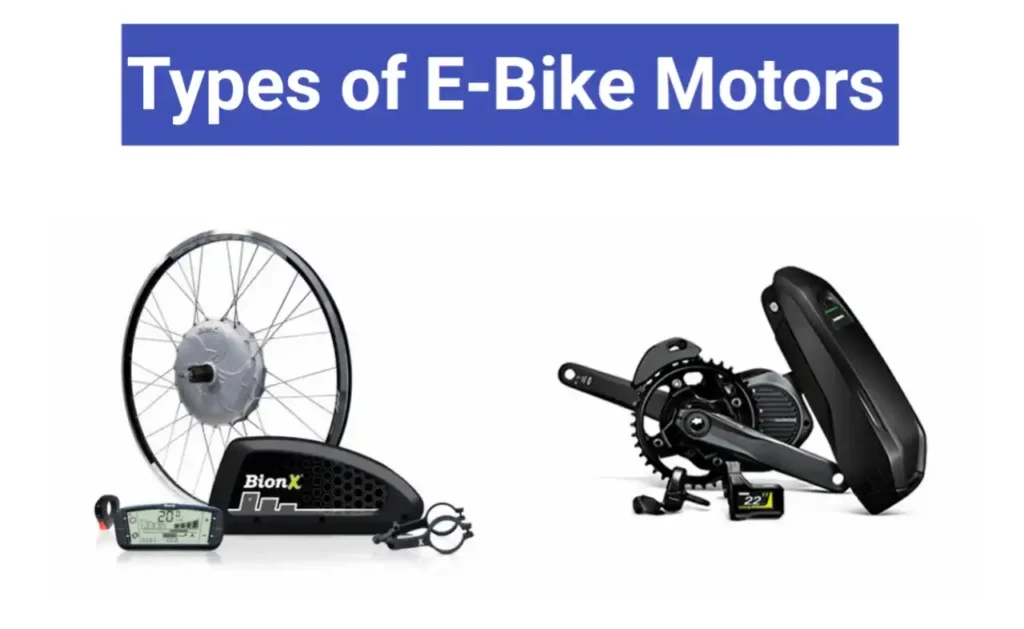Types of E-Bike Motors
Electric bikes, or e-bikes, have exploded in fashionability in recent times, offering a sustainable, effective, and pleasurable way to travel. One of the crucial factors that differentiates an e-bike from a traditional bike is the motor, the silent( or occasionally not- so-silent) force that propels you forward. But with colorful types, sizes, and features available, choosing the right types of e-bike motors can be inviting. Read:Best Electric Bike in the World
Table of Contents
This blog post aims to clarify the world of e-bikes motor , equipping you with the knowledge to make an informed decision for your coming electric lift.
What are the Different Types of E-Bike Motors
There are two main types of e-bike motors

1. Hub Motors
Integrated into the front or hinder wheel mecca, offering a cleaner and satiny look. Pros :
- Simple installation, frequent plug- and- play.
- Lower conservation conditions.
- Further affordable option.
Cons:
- Reduced power compared to mid-drive motors.
- Can affect handling due to weight in the wheel.
- Less effective on hilly terrain.
2. Mid-Drive Motors
Mounted directly on the frame, near the pedals, furnishing a more natural riding experience.
Pros
- Advanced power and necklace, ideal for hills and grueling terrain.
- Advanced weight distribution for better running.
- More effective power delivery.
Cons
- More complex installation, frequently taking professional backing.
- Advanced price point.
- May bear fresh chainring comity.
E-Bike Motor Specifications
Beyond the type, several crucial specifications impact your e-bike motor choice: Read:Electric Sports Bikes
1. Power( Watts)
- Measured in watts( W), it determines the motor’s overall strength and acceleration.
- Typical range for e-bikes 250W- 750W( regulations may vary).
- Advanced power offers further climbing capability and speed, but consumes further battery and may bear licensing in some regions.
2. Necklace( Newton- measures)
- Indicates the motor’s pulling power, pivotal for prostrating hills and starting from a deadlock.
- Advanced necklace translates to easier hill climbing and better running with weight.
3. Voltage( Volts)
- Represents the electrical implicit powering the motor, impacting overall performance and range.
- Common voltages 36V, 48V, and 72V( advanced voltage frequently correlates with advanced power and range).
4. Speed Detector
- Regulates motor backing grounded on pedal meter or wheel speed, icing a smooth and natural riding experience.
- Some motors offer necklace detectors for more responsive power delivery.
5. Freewheel
- Allows skimming when the motor isn’t engaged, mimicking the sense of a traditional bike.
- Not all motors have this point, impacting riding style and battery effectiveness.
Table:Quick Information
| Feature | Hub Motor | Mid-Drive Motor |
| Location | Integrated into wheel hub (front or rear) | Mounted on frame near pedals |
| Installation | Simpler, often plug-and-play | More complex, professional help recommended |
| Maintenance | Lower | Higher |
| Price | More affordable | Higher |
Chancing Your Perfect Match E-Bike Motors
Considerations for Different Riders The ideale-bike motor depends on your individual requirements and riding style Commuters conclude for a mecca motor for simplicity and affordability, prioritizing range and effectiveness. Recreational riders Consider a mid-drive motor for a more natural riding sense and better performance on varied terrain. Read:Splendor Electric Bike
Hill rovers Prioritize high necklace and power, leaning towards mid-drive options. Cargo vehicles Choose an important motor with a high necklace to handle the redundant weight effectively.
Final Thought
Powering Your trip Choosing the right e-bike motor is not just about specialized specifications; it’s about opting the perfect mate for your cycling adventures. Consider your riding style, terrain, budget, and ask performance to find the motor that empowers your peregrinations. Flash back,e-bikes are each about making cycling more pleasurable and accessible, so choose a motor that energies your passion for two- wheeled disquisition!
FAQS
Q Are e-bike motors noisy?
The noise position of an e-bike motor varies depending on the type and quality. mecca motors tend to be quieter, with a gentle droning sound. Mid-drive motors, especially high- performance bones,can be slightly louder, emitting a buzzing or whining noise. Still, ultramodern e-bikes are generally designed to be fairly quiet and should not disrupt your riding experience significantly.
Q How long does an e-bike motor last?
With proper care and conservation,e-bike motors can last for several times or indeed over 10,000 long hauls. Mecca motors generally bear lower conservation, while mid-drive motors might need occasional adaptations or element reserves. Regularly drawing and slicking the motor according to the manufacturer’s instructions can extend its lifetime.
Q Can I upgrade the motor on my e-bike?
An elevation of the motor is generally not recommended due to comity issues and implicit bond quashing. Also, it can be technically grueling and precious. It’s frequently better to trade in your current e-bike for one with a further suitable motor for your requirements.
Q Are e-bike motors leakproof?
Most e-bike motors are water- resistant and can handle rain and splashes. still, submerging them fully or pressure washing them isn’t judicious. Always consult your e-bike’s primer for specific recommendations on water resistance.
